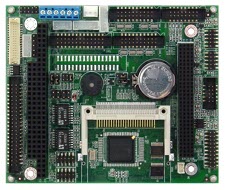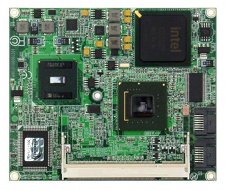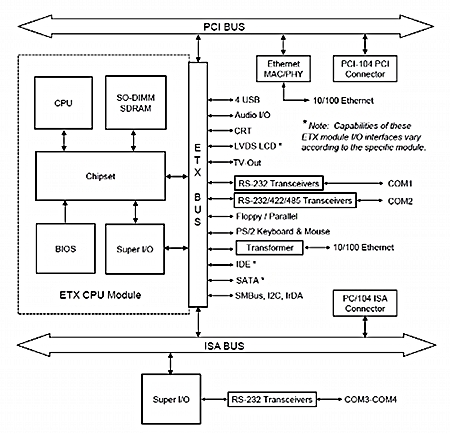Embedded computer combines ETX and PC/104-Plus
Jul 17, 2009 — by LinuxDevices Staff — from the LinuxDevices Archive — 7 views Diamond Systems is shipping a compact embedded computer that fits within the ETX (4.5 x 3.7 inches) footprint and offers PC/104-Plus expansion. Available with Intel's Atom N270 or Core Duo CPUs, the “Pluto” offers a CompactFlash slot, dual Ethernet ports, and four serial ports, says Diamond.
Diamond Systems is shipping a compact embedded computer that fits within the ETX (4.5 x 3.7 inches) footprint and offers PC/104-Plus expansion. Available with Intel's Atom N270 or Core Duo CPUs, the “Pluto” offers a CompactFlash slot, dual Ethernet ports, and four serial ports, says Diamond.
 Diamond's Neptune (Click image for further information) |
The interesting Pluto can be described as Diamond's latest variation on the ETX theme originally composed by Kontron. Last year, Diamond released the Neptune (right), a 6.5 x 4.5-inch SBC (single-board computer) designed to get its core CPU, memory, display, and networking capabilities from separately available ETX modules. Reportedly the first fruit of an alliance between Diamond and Kontron, the Neptune was offered with Kontron's ETX-LX, ETX-PM, or ETX-CD modules, providing processing power that ranges from a 500MHz AMD Geode LX 800 to a 1.5GHz Core 2 Duo.
Diamond's new Pluto once again uses ETX modules — manufacturer unspecified this time around — in a novel way. The device consists of an ETX module, rigidly mounted to a baseboard that shares the same 4.5 x 3.7-inch size. This approach offers enhanced thermal management, and increases the space available for I/O interface controllers and connectors, Diamond claims.
The Pluto's baseboard, pictured below left, has a PC/104-Plus socket that accepts PC/104 (ISA), PCI/104 (PCI), or PC/104-Plus (PCIe) expansion modules, plus a CompactFlash slot. The ETX module beneath it (below right) includes the CPU, northbridge, southbridge, plus a SODIMM socket that accepts up to 2GB of DDR2 memory, according to Diamond.


Diamond's Pluto has its baseboard on top (left) and an ETX module (right) below that
(Click either to enlarge)
The Pluto is initially available with a 1.6GHz Intel Atom N270, presumably employing the N270 processor, presumably with the usual 945GSE northbridge and ICH7M southbridge. According to Diamond, the device will also be offered with an alternative ETX module that sports a 1.66GHz Core Duo LV processor.

A block diagram of Pluto functionality
As you might guess by looking at it, the Pluto doesn't incorporate any "real world" connectors. However, Diamond offers cables — available in a complete set of 12, or singly — that connect to the device's pin headers and relay their signals to standard connectors. Interfaces, listed in their entirety in the table below, are said to include VGA, LVDS, and TV video outputs, two SATA ports, one IDE port, two 10/100 Ethernet ports, and four serial ports.
Features and specifications listed by Diamond Systems for the Pluto include the following:
- Processor — 1.6GHz Atom N270 or 1.66Ghz Core Duo LV
- Memory — Up to 2GB of DDR2 RAM via SODIMM slot
- Storage — CompactFlash slot, plus IDE and SATA interfaces
- Networking — 2 x 10/100 Ethernet
- Other I/O:
- 1 x VGA
- 1 x LVDS
- 1 x TV output
- 1 x IDE
- 2 x SATA
- 2 x PS/2
- 4 x USB 2.0
- 4 x serial (3 x RS232, 1 x RS232/422/485)
- Parallel/floppy port
- 8 x digital I/Os
- IrDA
- I2C
- Smbus
- Expansion:
- CompactFlash Type I/II socket
- PC/104-Plus socket
- Power requirements — 5VDC; also has 12VDC input option for peripherals
- Operating temperature:
- Atom version — -4 to 158 deg. F (-20 to 70 deg. C)
- Core Duo version — -40 to 185 deg. F (-40 to 85 deg. C)
- Dimensions — Height n/s; footprint 4.5 x 3.7 inches
Further information
According to Diamond Systems, the Pluto is shipping now, priced at approximately $600 with a 1.6Ghz Intel Atom N270, 1GB of RAM, and a heat spreader. The separately available cable kit costs $45.
Operating system support is said to currently include Linux 2.6 and Windows XP, with support for additional OSes and RTOSes being in the works. More information on the Pluto may be found on the Diamond Systems website, here.
This article was originally published on LinuxDevices.com and has been donated to the open source community by QuinStreet Inc. Please visit LinuxToday.com for up-to-date news and articles about Linux and open source.